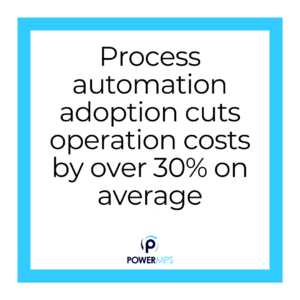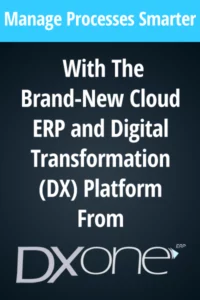Embracing artificial intelligence (AI) and automation is more than just a tech trend—it’s a strategic move that’s revolutionizing cost structures and resource allocation in businesses. As technologies advance, AI and automation demonstrate their potential to streamline processes, enhance efficiency, and allow customization in novel ways.
Saving Time Through Process Streamlining
AI and automation can reap substantial time savings by streamlining repetitive manual processes. Consider service calls – AI-powered chatbots handle basic customer queries without human agents, allowing them to focus on complex issues. Similarly, back-office tasks like PO processing and OCR of paper payments that once sucked up valuable worker hours are now automated.
A 2020 PwC study found over 50% of large global enterprises reported significant time savings through back-office automation. These automated document workflows cut processing times from weeks to hours for many companies. One insurance provider reduced claim processing by digitizing paperwork from 12 days to just three.
Freed from tedious administrative busywork, employees have time for high-impact strategic duties. Automating such rote tasks boosts productivity across organizations—one marketing agency automated contract generation, paring the process from days to under an hour. Employees refocused on new business pitches and saw proposal win rates surge by 25%. Offloading grunt work through streamlined digital processes unleashes massive productivity gains and labor cost reductions.
Enhancing Efficiency Through Intelligent Automation
 AI and automation enhance efficiency by performing tasks with superhuman capabilities. Advanced machine learning algorithms can rapidly analyze vast amounts of customer data, identifying patterns and trends that would be impossible for humans to detect. This augmented intelligence boosts marketing, customer service, and product development functions.
AI and automation enhance efficiency by performing tasks with superhuman capabilities. Advanced machine learning algorithms can rapidly analyze vast amounts of customer data, identifying patterns and trends that would be impossible for humans to detect. This augmented intelligence boosts marketing, customer service, and product development functions.
For example, algorithms can scan terabytes of customer purchase histories within seconds, uncovering purchasing habits and preferences. Marketers can leverage these insights to develop hyper-targeted campaigns. According to IBM, a single algorithm uncovered $300 million in additional annual revenue for one retailer.
Robotic process automation (RPA) provides another avenue for dramatic efficiency gains. RPAs emulate human actions to complete repetitive rules-based tasks around the clock. A survey by UI Path found RPA adoption cutting operation costs by over 30% on average in early adopting companies: Bots process invoices, data entry, and forms at superhuman speeds with perfect accuracy. One insurance company accelerated claims processing from weeks to days using RPA, improving the customer experience.
Allowing Flexible Process Customization
AI and automation also bring the advantage of adapting processes on the fly. With intelligent systems in place, workflows, and business logic can be tweaked easily through configuration instead of code. This allows non-technical staff to easily incorporate new rules, exceptions, and scenarios based on changing needs.
Consider how AI chatbots or RPA bots can be taught new responses, linked to different systems, or optimized to address atypical cases—all without reprogramming. The flexibility makes processes future-proof and continuously improving. As Robotic Process Automation Netherlands found, over 75% of responding enterprises report reductions in IT maintenance costs after deploying automation platforms for this reason[3].
Aligning AI with Business Strategy is Key
Appropriately directing AI initiatives requires aligning them with organizational goals and strategy. Leaders must thoughtfully determine how AI can augment competitive positioning and value propositions. Without this human element providing guidance, even the most advanced systems will lack focus.
The first step is assessing where AI can generate the most impact. A manufacturing firm aiming to cut costs and boost output might prioritize automating capital-intensive production processes. On the other hand, a consulting business focused on innovation could leverage AI for advanced data analytics and improving client-facing solutions. Performing a strategic review of core strengths and weaknesses helps identify optimal initial targets.
Equally important is establishing governance around AI projects. Clear ownership and oversight ensure technologies continually serve strategic objectives as they evolve. Periodic reviews check alignment and allow pivoting investments where needed. AI must flexibly support reshaping business models over time. Otherwise, there is a risk benefits fail to materialize or automation undermines human aspects critical for success. Strategic direction is what unlocks AI’s full potential value.
Measuring Impact and Continued Optimization
To truly maximize ROI, it is important that companies establish clear metrics for tracking AI and automation impact over time. Key performance indicators could include labor hours saved per project, reduced error rates, customer satisfaction gains, or increased revenue from improved processes. Benchmarking baseline performance allows quantifying improvements and refining strategies based on data.
Leading organizations also view AI implementation as an ongoing optimization process rather than a one-time project. As technologies and use cases advance, so too must the alignment of these systems with evolving core capabilities and operational needs. A flexible, metrics-driven approach keeps automation working hardest for the business on a continuous basis.
When embedded thoughtfully into strategic planning and enabled by the human element, AI and automation fundamentally have immense potential to alter cost structures for forward-thinking companies fundamentally. Proper execution can deliver time savings, efficiency boosts, and process flexibility that few other innovations rival. At the same time, the journey requires investment and discipline; the payoffs of streamlining mundane tasks through intelligent systems open new growth opportunities.







